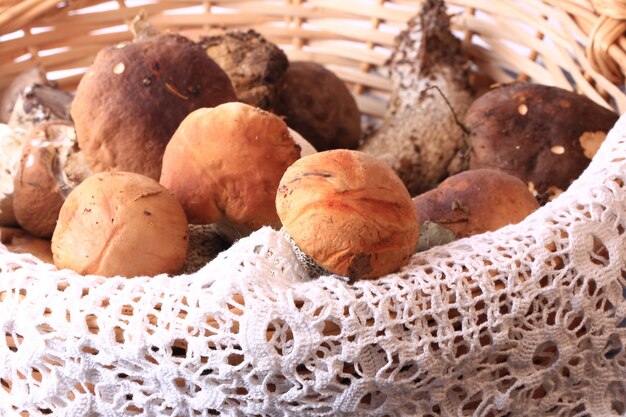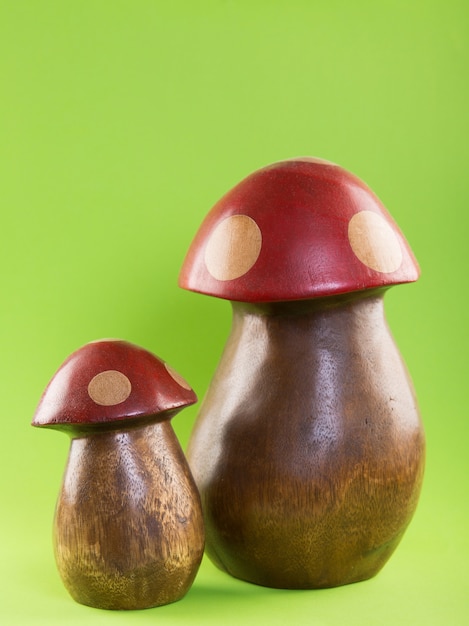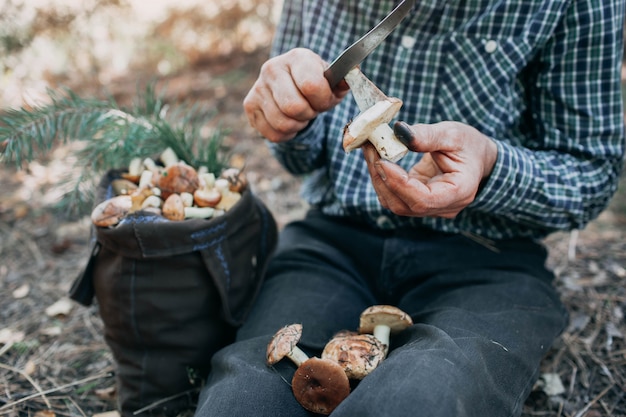Mushroom Foraging: Is This Trending Hobby Safe and Legal in the US?

Mushroom foraging has surged in popularity, raising questions about its safety, sustainability, and legality in the United States, as enthusiasts explore forests in search of edible fungi.
Suddenly, everyone seems to be talking about mushroom hunting. But is this new hobby, mushroom foraging, safe, sustainable, and legal in the US?
What’s Behind the Mushroom Foraging Trend?
Mushroom foraging, or mushroom hunting, has seen a significant surge in interest recently. Several factors contribute to this growing trend.
The popularity can be traced to a combination of factors, from increased awareness of wild foods to the desire for outdoor activities and a deeper connection with nature.
The Allure of Wild Foods
With a greater emphasis on natural and locally sourced foods, many people are drawn to the idea of harvesting their own meals from the wild.
- Nutritional Value: Wild mushrooms are often rich in vitamins, minerals, and antioxidants, making them a healthy addition to the diet.
- Unique Flavors: Foraging provides access to mushroom varieties not typically found in grocery stores, offering unique and gourmet flavors.
- Sense of Self-Sufficiency: Harvesting one’s own food fosters a sense of self-reliance and connection to the environment.
Seeking Outdoor Adventures
Many individuals and families are seeking outdoor activities that provide both exercise and relaxation. Mushroom foraging offers a unique blend of both.
- Exploration and Discovery: The thrill of discovering different mushroom species in their natural habitat can be incredibly rewarding.
- Physical Activity: Foraging involves hiking and exploring, promoting physical fitness and an active lifestyle.
- Mindfulness: The process of searching for mushrooms requires focus and attention, which can be a meditative and calming experience.
Connecting with Nature
In an increasingly urbanized world, many people are seeking ways to reconnect with nature and understand the natural world around them.
- Ecological Awareness: Mushroom foraging can lead to a greater understanding of ecosystems and the importance of biodiversity.
- Seasonal Appreciation: Foraging encourages an appreciation for the changing seasons and the rhythms of the natural world.
- Stress Relief: Spending time in nature has been shown to reduce stress and improve overall well-being.
Ultimately, the mushroom foraging trend is fueled by a desire for healthier foods, outdoor adventures, and a deeper connection with the natural world. These factors create an appealing combination for many people.
Is Mushroom Foraging Safe?
Safety is paramount when engaging in mushroom foraging. Misidentification can lead to severe health consequences, making proper precautions essential.
While foraging can be a rewarding experience, it’s crucial to prioritize safety to avoid potential health risks. This involves thorough research, proper identification, and careful handling of collected mushrooms.

Mushroom Identification
Accurate mushroom identification is crucial to ensure safety. Mistaking a poisonous mushroom for an edible one can have serious, even fatal, consequences.
- Learn from Experts: Join local mycological societies or attend guided foraging walks led by experienced experts.
- Use Multiple Identification Resources: Consult field guides, online databases, and mushroom identification apps to cross-reference findings.
- Focus on Key Features: Pay close attention to features such as cap shape, gill attachment, stem characteristics, spore print color, and odor.
Avoiding Poisonous Mushrooms
Familiarize yourself with the poisonous mushrooms that are common in your area. Understanding their characteristics will help you avoid accidental ingestion.
- Know the Deadly Species: Be aware of the “Destroying Angel” (Amanita species), “Death Cap” (Amanita phalloides), and other highly toxic mushrooms in your region.
- When in Doubt, Throw it Out: If you are unsure about the identification of a mushroom, discard it. Never consume a mushroom unless you are 100% certain it is safe.
- Handle with Care: Always wash your hands thoroughly after handling any wild mushrooms, even if you don’t intend to eat them.
Cooking and Consumption
Even edible mushrooms can cause adverse reactions if improperly prepared or consumed. Follow these guidelines to minimize risks.
- Cook Thoroughly: Always cook wild mushrooms thoroughly before eating. Some edible species contain toxins that are destroyed by heat.
- Start Small: When trying a new type of wild mushroom, eat only a small amount to test for any allergic reactions or sensitivities.
- Avoid Alcohol: Some mushrooms can react negatively with alcohol, so it’s best to avoid combining the two.
Taking these safety precautions can significantly reduce the risk of mushroom poisoning and ensure that foraging remains a safe and enjoyable activity. Always prioritize caution and respect for the potential dangers.
Is Mushroom Foraging Sustainable?
Sustainability is a crucial consideration when practicing mushroom foraging. Over-harvesting can negatively impact mushroom populations and the ecosystems they support.
Sustainable foraging practices ensure that mushroom populations can thrive for years to come. This involves responsible harvesting, respecting the environment, and promoting the long-term health of fungal habitats.
Responsible Harvesting Practices
Collecting mushrooms responsibly is essential for maintaining healthy populations. Avoid over-harvesting and use techniques that minimize disturbance to the surrounding environment.
- Leave Some Behind: Never collect all the mushrooms in a single area. Leave some to allow for spore dispersal and future growth.
- Use Proper Tools: Use a knife to carefully cut the mushroom stem above ground rather than pulling the entire mushroom out. This helps preserve the mycelium network underground.
- Avoid Trampling: Be mindful of where you step to avoid trampling delicate vegetation and disturbing the soil.
Protecting Mushroom Habitats
Preserving the natural habitats where mushrooms grow is crucial for their long-term survival. This includes protecting forests, woodlands, and other ecosystems.
- Stay on Trails: When foraging in forests, stick to established trails to minimize disturbance to the surrounding vegetation.
- Avoid Contamination: Do not litter or introduce any foreign materials to the environment. Pack out everything you pack in.
- Support Conservation Efforts: Contribute to local conservation organizations that work to protect natural habitats.
Educating Others
Sharing knowledge and promoting sustainable foraging practices can help ensure that mushroom populations remain healthy for future generations.
- Share Your Knowledge: Educate friends, family, and other foragers about responsible harvesting techniques.
- Participate in Citizen Science: Contribute to mushroom surveys and monitoring programs to help track mushroom populations and habitat changes.
- Advocate for Conservation: Support policies and initiatives that promote sustainable forest management and conservation.
By adopting responsible harvesting practices, protecting mushroom habitats, and educating others, foragers can contribute to the long-term sustainability of mushroom populations. This ensures that future generations can enjoy the benefits of wild mushrooms.

Is Mushroom Foraging Legal in the US?
The legality of mushroom foraging in the US varies depending on location and land ownership. Understanding local regulations is essential to avoid legal issues.
Foraging laws can differ based on whether you’re on private, state, or federal lands. Always check and comply with local regulations to ensure you’re foraging legally and responsibly.
Private Land
Foraging on private land without permission is generally illegal. Always obtain consent from the landowner before collecting any mushrooms.
- Seek Permission: Always ask for permission from the landowner before foraging on private property.
- Respect Boundaries: Adhere to any posted signs or restrictions regarding access to the property.
- Liability: Be aware that landowners may not be liable for injuries sustained while foraging on their property unless negligence can be proven.
State Land
Many states allow mushroom foraging on state-owned lands, but regulations may vary. Check with the relevant state agency for specific rules and restrictions.
- Permits: Some states require permits for mushroom foraging on state lands. Contact the state’s Department of Natural Resources or equivalent agency for information.
- Quantity Limits: States may impose limits on the quantity of mushrooms that can be collected for personal use.
- Protected Areas: Certain state parks or nature reserves may be off-limits to foraging. Check regulations before entering these areas.
Federal Land
Federal lands, such as national forests and national parks, often have specific regulations regarding mushroom foraging. These regulations aim to balance recreational use with conservation efforts.
- National Forests: Many national forests allow mushroom foraging for personal use, but commercial harvesting may require a permit. Contact the local Forest Service office for details.
- National Parks: National parks typically prohibit or severely restrict mushroom foraging to protect park ecosystems. Check with the park’s visitor center or website for current regulations.
- Wilderness Areas: Foraging in designated wilderness areas may be subject to additional restrictions to preserve the pristine nature of these areas.
Before engaging in mushroom foraging, it is crucial to research and understand the regulations that apply to the specific location where you plan to forage. This will help you avoid legal issues and ensure that you are foraging responsibly and ethically.
Tips for Beginner Mushroom Foragers
Starting out with mushroom foraging can be intimidating, but with the right approach, it can become a rewarding and enjoyable hobby.
Beginners should focus on learning the basics of mushroom identification, understanding local regulations, and practicing safe and sustainable foraging techniques.
Start with Easy-to-Identify Species
Begin with mushrooms that are relatively easy to identify and have few or no poisonous look-alikes. This will help build confidence and reduce the risk of misidentification.
- Morels (Morchella spp.): These distinctive, honeycomb-shaped mushrooms are relatively easy to identify and highly prized by foragers.
- Chanterelles (Cantharellus spp.): With their bright yellow to orange color and distinctive fruity aroma, chanterelles are another good option for beginners.
- Oyster Mushrooms (Pleurotus spp.): These shelf-like mushrooms grow on trees and are generally easy to identify based on their appearance and substrate.
Join a Local Mycological Society
Joining a local mycological society can provide access to valuable resources, including guided foraging walks, workshops, and expert advice.
- Learn from Experts: Mycological societies often have experienced members who can help you learn how to identify mushrooms safely and accurately.
- Connect with Other Foragers: Joining a society provides an opportunity to connect with other mushroom enthusiasts and share knowledge and experiences.
- Participate in Events: Societies often organize foraging walks, workshops, and other events that can enhance your knowledge and skills.
Use Field Guides and Identification Apps
Field guides and identification apps can be valuable tools for identifying mushrooms, but they should be used in conjunction with other resources and expert advice.
- Choose Reliable Resources: Select field guides and apps that are accurate, up-to-date, and specific to your geographic region.
- Cross-Reference Findings: Always cross-reference information from multiple sources to confirm your identification.
- Be Cautious: Remember that even the best field guides and apps are not foolproof. If you are unsure about the identification of a mushroom, err on the side of caution and discard it.
By starting with easy-to-identify species, joining a local mycological society, and using reliable identification resources, beginner foragers can build a solid foundation of knowledge and skills. This will help ensure that foraging remains a safe, rewarding, and sustainable activity.
The Future of Mushroom Foraging
As mushroom foraging gains popularity, it is important to consider its future and how to ensure its sustainability and safety.
The increasing interest in foraging calls for a balanced approach that promotes responsible practices, conservation efforts, and ongoing education to maintain the integrity of mushroom ecosystems.
Promoting Responsible Foraging
Education and awareness can play a key role in promoting responsible foraging practices and minimizing the negative impacts of over-harvesting.
- Educational Programs: Develop and promote educational programs that teach foragers about sustainable harvesting techniques and the importance of protecting mushroom habitats.
- Community Engagement: Engage local communities in conservation efforts and encourage them to participate in monitoring and management programs.
- Certification Programs: Consider implementing certification programs for commercial foragers to ensure that they are adhering to sustainable practices.
Conservation Efforts
Protecting and restoring mushroom habitats is essential for ensuring the long-term survival of mushroom populations.
- Habitat Preservation: Support efforts to protect forests, woodlands, and other ecosystems that provide habitat for mushrooms.
- Restoration Projects: Implement restoration projects to rehabilitate degraded mushroom habitats and promote fungal diversity.
- Research and Monitoring: Invest in research and monitoring programs to track mushroom populations and habitat changes over time.
Technological Advancements
Technology can play a significant role in improving mushroom identification, monitoring mushroom populations, and promoting sustainable foraging practices.
- AI-Powered Identification: Develop AI-powered apps and tools that can help foragers accurately identify mushrooms based on images and other characteristics.
- Remote Sensing: Use remote sensing technologies to monitor mushroom habitats and detect changes in vegetation cover and environmental conditions.
- Blockchain Technology: Implement blockchain technology to track the provenance of wild mushrooms and ensure that they are harvested sustainably and legally.
The future of mushroom foraging depends on our ability to promote responsible practices, protect mushroom habitats, and leverage technology to enhance our understanding of fungal ecosystems. By working together, we can ensure that future generations can continue to enjoy the benefits of wild mushrooms while preserving the natural world around us.
| Key Point | Brief Description |
|---|---|
| 🍄 Safety First | Accurate identification is crucial to avoid poisonous mushrooms. |
| 🌍 Sustainability | Harvest responsibly to protect mushroom populations and habitats. |
| ⚖️ Legality | Know the laws for foraging on private, state, and federal lands. |
| 🌱 Beginner Tips | Start with easy species, join a society, and use reliable resources. |
Frequently Asked Questions (FAQ)
▼
Only consume mushrooms you’ve positively identified as edible. When in doubt, throw it out. Cook all wild mushrooms thoroughly, and start with small amounts to test for reactions.
▼
Leave some mushrooms behind to allow for spore dispersal. Use proper tools like a knife to cut the stem. Avoid trampling vegetation and disturbing soil. Respect the environment.
▼
Legality varies by location. Always get permission for private land foraging. State and federal lands may have specific regulations, permits, and quantity limits. Check local rules before foraging.
▼
Good beginner mushrooms include morels (Morchella spp.), chanterelles (Cantharellus spp.), and oyster mushrooms (Pleurotus spp.). These are relatively easy to identify with fewer poisonous look-alikes.
▼
Mycological societies offer guided walks, workshops, and expert advice. You can learn from experienced members, connect with fellow foragers, and participate in events to enhance your skills safely.
Conclusion
As mushroom foraging grows in popularity, understanding its implications for safety, sustainability, and legality is essential. By prioritizing education, responsible practices, and conservation efforts, we can ensure that this rewarding hobby remains enjoyable and beneficial for future generations, while preserving the delicate balance of our ecosystems.